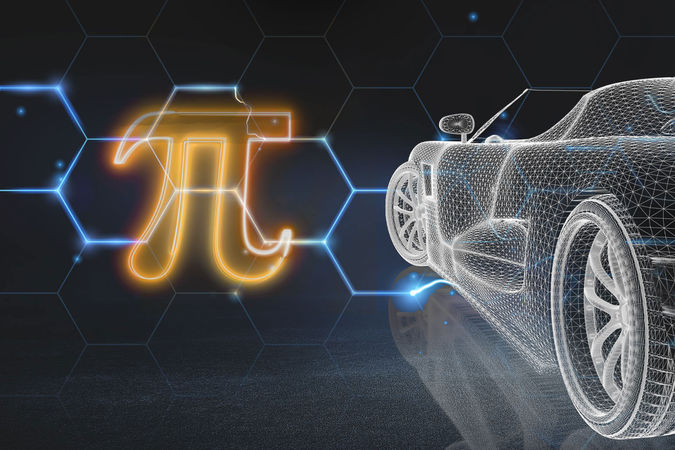Pi (π) is the 16th letter of the Greek alphabet, and is used to represent the most widely known mathematical constant.
Pi has been known for nearly 4,000 years and was discovered by ancient Babylonians. A tablet from somewhere between 1900-1680 B.C. found pi to be 3.125. The ancient Egyptians were making similar discoveries, as evidenced by the Rhind Papyrus of 1650 B.C.
By definition, pi is the ratio of the circumference of a circle to its diameter. In other words, pi equals the circumference divided by the diameter (π = c/d). Conversely, the circumference of a circle is equal to pi times the diameter (c = πd). No matter how large or small a circle is, pi will always work out to be the same number. That number equals approximately 3.14, but it’s a little more complicated than that.

Pi is an irrational number, which means that it is a real number that cannot be expressed by a simple fraction. That’s because pi is what mathematicians call an “infinite decimal” — after the decimal point, the digits go on forever and ever. The website piday.org has pi listed to the first million digits.
Lately, „Pi“ has been mentioned in several ground-breaking inventions. Most recently, Elon Musk unexpectedly announced a video introducing the concept of the new smartphone on the Tesla website. This smart mobile phone is called Tesla Model π (or Tesla Model Pi).
According to the introductory video, Tesla’s smartphone Pi can be connected to the Starlink satellite network. Starlink is a SpaceX-operated satellite broadband constellation that provides satellite Internet connectivity to the majority of the Earth’s surface. Starlink is a global provider of high-speed, low-latency broadband internet. Starlink uses powerful satellites in low orbit to enable video chats, online gaming, streaming, and other high-bandwidth activities that had previously been impossible with satellite internet. It’s how Starlink makes internet access available from any place. In most cases, users may anticipate download rates of 100 to 200 megabits per second and latency as low as 20 milliseconds. It’s the ideal companion for the next-generation smartphone.
And while Tesla is using „Pi“ to announce a phone that with the help of Starlink will be able to connect humans around the world with a solid internet connection no matter where they are, a company called the Neutrino Energy Group in Berlin is working on taking electrical devices off the grid by providing a truly decentralized way of generating electricity called „Pi-Technology“.
Mobile devices, including smartphones and tablets, have revolutionized the way we process data and access the internet. Despite their impressive usefulness and convenience, however, contemporary mobile devices have a fatal flaw. They must periodically be plugged into power outlets to be recharged. The Neutrino Energy Group is not only working on liberating appliances like our smartphones and tablets from the fossil-fuel energy grid, but also turning around electric mobility by creating the „PI-Car“ using the same ground-breaking technology.
Pi Technology is coming soon
By Harvesting the energy of vicinity, the Pi-Technology proposed by the Neutrino Energy Group is the world’s first form of truly decentralized, sustainable energy. Consumers around the world are being encouraged to buy electric automobiles under the illusion that they are better for the environment. While electric vehicles have the potential to cut emissions, charging electric car batteries using traditional electrical grids, which predominantly utilize coal to generate energy, has the potential to cause significant global issues created by fossil fuel emissions.
Dr. Bharat Bhanudas Kale of Pune, Maharashtra, was recently welcomed into the Neutrino Energy Group. Dr. Kale has been chosen to be a leader in the Neutrino Energy Group’s Car Pi project.
Dr. Bharat Bhanudas Kale is one of India’s most prominent research scientists in some of the world’s most significant scientific fields, with over 20 patents to his name, more than 250 international journal publications, and nearly 30 years of experience in sustainable energy and nanomaterial technologies. He is a founding member of the Pune-based Centre for Materials for Electronics Technology (C-MET), and he will be inducted as a Fellow of the Royal Society of Chemistry in 2020.
Dr. Kale’s significant experience in sustainable energy technologies made him an excellent choice for the Neutrino Energy Group, but it was his extra expertise in innovative nanomaterials that clinched the deal. The Neutrino Energy Group has been working on developing a brand-new method of consumer conveyance that uses neutrino energy rather than coal-generated electricity or fossil fuels for quite some time, and Dr. Kale’s research into metamaterials made him the ideal scientist to bring this project to fruition.
The Car Pi: Invisible radiation transformed by metamaterials will power tomorrow’s electric automobiles
The Neutrino Energy Group’s proposed electric vehicle, known as the Car Pi, will also be powered by nothing more than the endless stream of elementary particles, electromagnetic waves, temperature differences, electro smog, neutrinos, and other natural and artificial invisible radiation that passes through us and everything we see every moment of every day. This ground-breaking invention will forever alter the way people across the world utilize automobiles. The Neutrino Energy Group Board of Directors has decided that Dr. Bharat Kale will be one of the project’s leaders.

Dr. Kale plans to use metamaterials to manufacture the complete body of the Car Pi after receiving approval from the Neutrino Energy Group. A metamaterial is a material that has been artificially constructed to have properties that are not available in natural materials, and these artificial materials express their unique characteristics based on the arrangement of their molecules rather than the base materials from which they are fabricated.
Metamaterials provide a number of advantages in the context of vehicle building that might increase efficiency and safety. Because proximity powered cars must be incredibly energy-efficient in order to function properly, metamaterials are perfect building materials for the Car Pi project. Dr. Kale and his colleagues will make the Car Pi accessible on the worldwide market after they have successfully developed a prototype.
The Neutrino Energy Group is transforming electric vehicles into truly sustainable vehicles
The Neutrino Energy Group’s Car Pi will be unlike anything the world has ever seen before, but that’s part of the plan. While the rest of the world was still scratching its heads in the aftermath of the 2015 discovery that neutrinos have mass, the Neutrino Energy Group was hard at work developing the Pi-Technology.
Much like the recently found trilayer graphene superconducting Material, a component of CEO Holger’s neutrino energy technology, Thorsten Schubart’s team uses extremely thin graphene layers to produce a resonance from passing invisible radiation and transform kinetic energy into electricity. Spiked graphene and silicon are glued to a suitable substrate in this way, and when passing radiation of elementary particles strikes this combination of nano-sized silicon and graphene, a harmonic resonance process occurs, which is subsequently recognized by an electrical conversion device.


